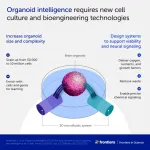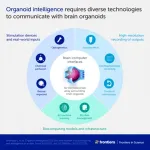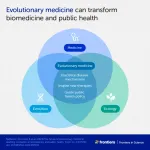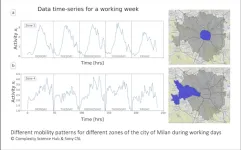(Press-News.org) Artificial intelligence (AI) has long been inspired by the human brain. This approach proved highly successful: AI boasts impressive achievements – from diagnosing medical conditions to composing poetry. Still, the original model continues to outperform machines in many ways. This is why, for example, we can ‘prove our humanity’ with trivial image tests online. What if instead of trying to make AI more brain-like, we went straight to the source?
Scientists across multiple disciplines are working to create revolutionary biocomputers where three-dimensional cultures of brain cells, called brain organoids, serve as biological hardware. They describe their roadmap for realizing this vision in the journal Frontiers in Science.
“We call this new interdisciplinary field ‘organoid intelligence’ (OI),” said Prof Thomas Hartung of Johns Hopkins University. “A community of top scientists has gathered to develop this technology, which we believe will launch a new era of fast, powerful, and efficient biocomputing.”
What are brain organoids, and why would they make good computers?
Brain organoids are a type of lab-grown cell-culture. Even though brain organoids aren’t ‘mini brains’, they share key aspects of brain function and structure such as neurons and other brain cells that are essential for cognitive functions like learning and memory. Also, whereas most cell cultures are flat, organoids have a three-dimensional structure. This increases the culture's cell density 1,000-fold, meaning that neurons can form many more connections.
But even if brain organoids are a good imitation of brains, why would they make good computers? After all, aren't computers smarter and faster than brains?
"While silicon-based computers are certainly better with numbers, brains are better at learning,” Hartung explained. “For example, AlphaGo [the AI that beat the world’s number one Go player in 2017] was trained on data from 160,000 games. A person would have to play five hours a day for more than 175 years to experience these many games.”
Brains are not only superior learners, they are also more energy efficient. For instance, the amount of energy spent training AlphaGo is more than is needed to sustain an active adult for a decade.
“Brains also have an amazing capacity to store information, estimated at 2,500TB,” Hartung added. “We’re reaching the physical limits of silicon computers because we cannot pack more transistors into a tiny chip. But the brain is wired completely differently. It has about 100bn neurons linked through over 1015 connection points. It’s an enormous power difference compared to our current technology.”
What would organoid intelligence bio computers look like?
According to Hartung, current brain organoids need to be scaled-up for OI. "They are too small, each containing about 50,000 cells. For OI, we would need to increase this number to 10 million,” he explained.
In parallel, the authors are also developing technologies to communicate with the organoids: in other words, to send them information and read out what they’re ‘thinking’. The authors plan to adapt tools from various scientific disciplines, such as bioengineering and machine learning, as well as engineer new stimulation and recording devices.
“We developed a brain-computer interface device that is a kind of an EEG cap for organoids, which we presented in an article published last August. It is a flexible shell that is densely covered with tiny electrodes that can both pick up signals from the organoid, and transmit signals to it,” said Hartung.
The authors envision that eventually OI would integrate a wide range of stimulation and recording tools. These will orchestrate interactions across networks of interconnected organoids that implement more complex computations.
Organoid intelligence could help prevent and treat neurological conditions
OI’s promise goes beyond computing and into medicine. Thanks to a groundbreaking technique developed by Noble Laureates John Gurdon and Shinya Yamanaka, brain organoids can be produced from adult tissues. This means that scientists can develop personalized brain organoids from skin samples of patients suffering from neural disorders, such as Alzheimer’s disease. They can then run multiple tests to investigate how genetic factors, medicines, and toxins influence these conditions.
“With OI, we could study the cognitive aspects of neurological conditions as well,” Hartung said. “For example, we could compare memory formation in organoids derived from healthy people and from Alzheimer’s patients, and try to repair relative deficits. We could also use OI to test whether certain substances, such as pesticides, cause memory or learning problems.”
Taking ethical considerations into account
Creating human brain organoids that can learn, remember, and interact with their environment raises complex ethical questions. For example, could they develop consciousness, even in a rudimentary form? Could they experience pain or suffering? And what rights would people have concerning brain organoids made from their cells?
The authors are acutely aware of these issues. “A key part of our vision is to develop OI in an ethical and socially responsible manner,” Hartung said. “For this reason, we have partnered with ethicists from the very beginning to establish an ‘embedded ethics’ approach. All ethical issues will be continuously assessed by teams made up of scientists, ethicists, and the public, as the research evolves.”
How far are we from the first organoid intelligence?
Even though OI is still in its infancy, a recently-published study by one of the article’s co-authors – Dr Brett Kagan of the Cortical Labs – provides proof of concept. His team showed that a normal, flat brain cell culture can learn to play the video game Pong.
“Their team is already testing this with brain organoids,” Hartung added. “And I would say that replicating this experiment with organoids already fulfills the basic definition of OI. From here on, it’s just a matter of building the community, the tools, and the technologies to realize OI’s full potential,” he concluded.
END
Scientists unveil plan to create biocomputers powered by human brain cells
Despite AI’s impressive track record, its computational power pales in comparison with a human brain. Now, scientists unveil a revolutionary path to drive computing forward: organoid intelligence, where lab-grown brain organoids act as biological hardware
2023-02-28
ELSE PRESS RELEASES FROM THIS DATE:
From anti-antibiotics to extinction therapy: how evolutionary thinking can transform medicine
2023-02-28
The word ‘evolution’ may bring to mind dusty dinosaur bones, but it impacts our health every day. For example, even though antibiotics were invented only a century ago, the evolution of antibiotic resistance is already a major concern. The rise in modern health problems such as obesity can also be traced back to evolutionary principles.
An article published in Frontiers in Science demonstrates how applying an evolutionary perspective to medicine can inspire new ways of preventing and treating disease.
“Evolutionary medicine holds promise to transform our understanding of why we get sick ...
Researchers from the Institute of Botany discovered a new type of coexistence between algae and fungi
2023-02-28
Researchers from the Institute of Botany, Czech Academy of Sciences, described the symbiotic relationship between fungi and algae which science has largely overlooked until now. The coexistence of algae and corticioid basidiomycetes, which are common in temperate forests, has been given a new name: alcobiosis.
Jan Vondrák of the Department of Taxonomy, Institute of Botany, and the first author of the study says “Years ago, during field trips, we were repeatedly puzzled to find a layer of green algae where some of the fungal coatings on wood or bark (so-called corticioid fungi) are disturbed. We discovered that this is a ...
The largest genomic study of rare cancer metastathic pheochromocytoma identifies patients at highest risk of metastasis and those who would respond to immunotherapy
2023-02-28
The new results will help to follow patients with a bad prognosis more closely, and to move towards more personalized treatments.
Mercedes Robledo, co-lead author, has been studying pheochromocytomas since 1996 and leads the CNIO group that has identified 5 of the 22 genes associated with these rare tumors.
The research analyzes an "exceptionally high" number of samples, something very difficult in rare diseases and achieved thanks to the collaboration of centers from countries all over the world.
Pheochromocytoma is a rare tumor, with an ...
How to predict city traffic
2023-02-28
A new machine learning model can predict traffic activity in different zones of cities. To do so, a Complexity Science Hub researcher used data from a main car-sharing company in Italy as a proxy for overall city traffic. Understanding how different urban zones interact can help avoid traffic jams, for example, and enable targeted responses of policy makers - such as local expansion of public transportation.
Understanding people's mobility patterns will be central to improving urban traffic flow. “As populations grow in urban areas, this knowledge can help policymakers design and implement effective transportation ...
Parental support for LGBTQ youth is important, research shows
2023-02-28
Depression is more widespread among lesbian, gay, bisexual, transgender, or questioning (LGBTQ) youth than heterosexual, cisgender youth, making parental support more important for these adolescents. A new study released in Child Development by researchers at The University of Texas at Austin looks at parental social support and psychological control in relation to depressive symptoms for LGBTQ youth in the United States. Psychological control attempts to intrude into the psychological and emotional development of the child (e.g., thinking processes, self-expression, emotions, and attachment to parents). Although ...
SUTD to launch south-east Asia’s first O-RAN Open Testing and Integration Centre (OTIC)
2023-02-28
SUTD to Launch South-east Asia’s First O-RAN Open Testing and Integration Centre (OTIC)
Announced at the Mobile World Congress Barcelona (MWC) 2023, Singapore University of Technology and Design (SUTD) will launch a new O-RAN[1] Asia & Pacific Open Testing and Integration Centre (OTIC) in Singapore. As part of Singapore’s S$70 million Future Communications R&D Programme (FCP) supported by Singapore’s Infocomm Media Development Authority (IMDA) and the National Research Foundation, Singapore (NRF), the Asia & Pacific OTIC in Singapore ...
12 exotic bacteria found to passively collect rare earth elements from wastewater
2023-02-28
Rare earth elements (REEs) are a group of 17 chemically similar metals, which got their name because they typically occur at low concentrations (between 0.5 and 67 parts per million) within the Earth’s crust. Because they are indispensable in modern technology such as light emitting diodes, mobile phones, electromotors, wind turbines, hard disks, cameras, magnets, and low-energy lightbulbs, the demand for them has increased steadily over the past few decades, and is predicted to rise further by 2030.
As ...
Will future computers run on human brain cells?
2023-02-28
A “biocomputer” powered by human brain cells could be developed within our lifetime, according to Johns Hopkins University researchers who expect such technology to exponentially expand the capabilities of modern computing and create novel fields of study.
The team outlines their plan for “organoid intelligence” today in the journal Frontiers in Science.
“Computing and artificial intelligence have been driving the technology revolution but they are reaching a ceiling,” said Thomas Hartung, a professor of environmental health sciences at ...
Study reveals improvements in workplace support and leadership training will improve the mental health and potentially reduce burnout in healthcare professionals
2023-02-28
Amongst healthcare professionals, the feeling of being supported in the workplace can protect them against adverse mental health and burnout, according to a new study published in CMAJ Open by researchers at Queen Mary University of London and medical staff at various hospitals across the UK.
CoPE-HCP study was designed, during the early part of COVID-19 pandemic, when there was great concern for the mental health of healthcare professionals with no scientifically-proven mitigating strategies to reduce that impact. Funded by Barts Charity, this new longitudinal study found that feeling unsupported ...
Immune system drug shows promise in treating alcohol use disorder, a Scripps Research clinical trial reports
2023-02-28
LA JOLLA, CA—A clinical trial carried out at Scripps Research has shown that apremilast, approved by the U.S. Food and Drug Administration (FDA) for the treatment of psoriasis, cuts alcohol intake by more than half in people with severe alcohol use disorder (AUD). Collaborators at Oregon Health and Science University (OHSU) and other institutions also showed that, in mice, apremilast boosts activity in an area of the brain known to be involved in AUD.
The research was published online ahead of ...
LAST 30 PRESS RELEASES:
World-first discovery uncovers how glioblastoma tumours dodge chemotherapy, potentially opening the door to new treatments
A fatal mix-up: How certain gut bacteria drive multiple sclerosis
New AI tool identifies not just genetic mutations, but the diseases they may cause
Deep-learning model predicts how fruit flies form, cell by cell
Combination pills for high blood pressure may simplify treatment, improve long-term health
Immune system keeps mucosal fungi in check
Neurons within the brain use simple rules to localize genetic messages
Electrodes created using light
Second-hand gift-giving is a well-deliberated decision
How human interaction drove evolution to make bears less aggressive
National Poll: Few parents offer teens guidance on healthy eating during holiday season
Cannabis derivatives could provide new ovarian cancer treatments
Raising strong yeast as a petroleum substitute
Clues to the origin of hot Jupiters hidden in their orbits
Canada’s reduced pledge to Global Fund will impact domestic health
1 in 4 children with major traumatic injuries not cared for in pediatric trauma centres
Duke and Duke-NUS’ joint cross-population research to uncover "East-West" differences in disease and care
Scientists to ‘spy’ on cancer- immune cell interactions using quantum technology breakthrough
Tech savvy users have most digital concerns
Making lighter work of calculating fluid and heat flow
Normalizing blood sugar can halve heart attack risk
Lowering blood sugar cuts heart attack risk in people with prediabetes
Study links genetic variants to risk of blinding eye disease in premature infants
Non-opioid ‘pain sponge’ therapy halts cartilage degeneration and relieves chronic pain
AI can pick up cultural values by mimicking how kids learn
China’s ecological redlines offer fast track to 30 x 30 global conservation goal
Invisible indoor threats: emerging household contaminants and their growing risks to human health
Adding antibody treatment to chemo boosts outcomes for children with rare cancer
Germline pathogenic variants among women without a history of breast cancer
Tanning beds triple melanoma risk, potentially causing broad DNA damage
[Press-News.org] Scientists unveil plan to create biocomputers powered by human brain cellsDespite AI’s impressive track record, its computational power pales in comparison with a human brain. Now, scientists unveil a revolutionary path to drive computing forward: organoid intelligence, where lab-grown brain organoids act as biological hardware







